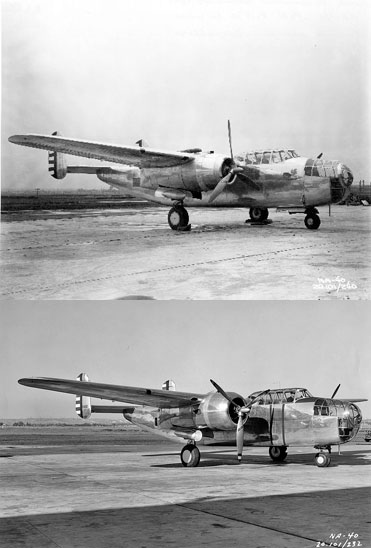NA-40 / NA-40B
History
Before I get too deep in the history of the NA-40, it is important to note that the NA-40 was not a B-25. It was also not the prototype for the B-25. The NA-40 was indeed a totally separate aircraft. The B-25 bomber had no prototype as it was developed as it was built. You may be wondering why I have included the history of the NA-40 here on a B-25 website. The answer to that is in the history.
The NA-40 was North American Aviation's entry in the twin engine attack bomber competition of 1938. Although North American lost the competition for this contract, the testing of the NA-40 proved an impressive proof of concept. Early on, the aircraft was plagued with problems. All of these problems were overcome with eventual design changes. The engineering design team headed by Howard Evans had produced an excellent aircraft.
The NA-40 design was based on a crew of 5. This would include: a pilot, co-pilot, bombardier/navigator, radio operator/gunner, and gunner. The pilot and co-pilot were seated in tandem. A greenhouse nose was fitted for the bombardier/navigator and the radio operator and gunner were seated aft. This arrangement allowed for a maximum fuselage width of 45 inches. The wings were shoulder mounted, constant dihedral with fully underhung nacelles. The NA-40 was powered by two Pratt & Whitney engines with three blade Curtiss electric propellers. She was outfitted with three .30 caliber flexible guns with 500 rounds each. Bays for two fixed .30 caliber guns were designed into each wing, but these were not initially fitted. On initial test flights, the NA-40 proved unstable. As a result, she only flew fourteen test flights for a total of five hours and twenty minutes.
The initial test flights proved to North American that the aircraft needed bigger power plants and more streamlined aerodynamics. Between February 28, and March 1, 1939, the NA-40 underwent a design overhaul. The two wing mounted .30 caliber machine guns were mounted. The Pratt & Whitney engines were replaced by Wright engines. The Curtiss electric propellers were kept, although the intention was to replace them with Hamilton Standard Hydromatic propellers. The Hamilton propellers were capable of full feathering faster than the Curtiss electric propellers. They were, however, not available at that time. The NA-40 airframe was re-designated as the NA-40B. She was given the civil registration of X14221. The improvements were completely successful and testing continued. On April 11, 1939, during single engine testing, the aircraft lost altitude and crashed. All on board were uninjured. Shortly after the crew exited the plane, she broke into flames and was completely destroyed.
NA-40 Specs |
- Model: NA-40
- Total Produced: 1
- Manufacturing Plant: Inglewood, California
- First Test Flight: January 29, 1939
- First Flight Crew: Pilot: Balfour, Engineer: Lyons
- Engines: Pratt & Whitney R-1830-S6C3-6
- Carburetors:
- Fuel Capacity:
- 476 gallons
- Armament:
- Ball mounted .30 caliber in nose, 500 rounds
- .30 caliber in top turret, 500 rounds
- .30 caliber portable between aft waist and ventral locations, 500 rounds
- Armor Protection: None
- Weights: Empty: 19,500 lbs
- Speed (Max): 268 mph
- Service Ceiling: 26,000 ft
- Range: 1,245 miles
- Crew:
- Pilot, co-pilot, bombardier/navigator, radio operator/gunner, gunner
- First Airplane Accepted: N/A
- Last Airplane Accepted: N/A
- Photos:
NA-40B Specs |
- Model: NA-40B
- Total Produced: 1 (modified from the NA-40)
- Manufacturing Plant: Inglewood, California
- First Test Flight: March 1, 1939
- First Flight Crew: Pilot: Balfour, Co-Pilot: Lyons, Engineer: Wheeler
- Engines: Wright R-2600-A71-3
- Carburetors:
- Fuel Capacity:
- 476 gallons
- Armament:
- Ball mounted .30 caliber in nose, 500 rounds
- .30 caliber in top turret, 500 rounds
- .30 caliber portable between aft waist and ventral locations, 500 rounds
- .30 caliber in each wing, 500 rounds each
- Armor Protection: None
- Weights: Empty: 20,000 lbs
- Speed (Max): 287 mph
- Service Ceiling: 25,000 ft
- Range: 1,176 miles
- Crew:
- Pilot, co-pilot, bombardier/navigator, radio operator/gunner, gunner
- First Airplane Accepted: N/A
- Last Airplane Accepted: N/A
- Photos:

